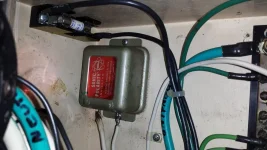egaito
Legendary Member
- Joined
- Jun 27, 2005
- Messages
- 1,153
- Status
- OWNER - I own a Hatteras Yacht
- Hatteras Model
- 41' CONVERTBLE-Series I (1964 - 1971)
Mystyfying Electrical Issue
Forgive the play on words....
I'm trying to track down an electrical issue on the boat that seems to be relatively new and am running out of ideas. It's a bit of a long story, but I'm hoping the clues will
help generate some fresh ideas as I'm out of them.
I'm helping a guy out that is developing an ELCI test rig for power leakage between the boat and pedestal. So before taking him on as a client, I wanted to see what he had. I plugged it in between Misty and the dock, and to my surprise, it alarmed immediately. I tried it on the other cord with the same result.
Next we clamped the shore power cords (two 30 amp cords), which should read 0. Instead, I got a reading of several amps, the same reading on both cords and now I'm getting really concerned.
To make sure the boat wasn't a danger to anyone, we put a probe in the water around the boat, and even touched the running gear. Thankfully, there is no voltage going into the water. Apparently the grounding system is doing it's job.
Here are the other clues I'm working with:
The amperage I'm reading from both cords is directly proportional to the total load on the boat. Somehow the issue is crossing between the panels.
If I turn everything on, (stove, oven, AC, Hot water, etc) to load up the system, both dockside breakers pop simultaneously at about 28 to 30 amps. This is a first for me...I've overloaded on or the other at times but have never experienced anything like this.
I've tried turning off individual circuits to see if I could isolate a bad appliance. No luck there. The load goes down (indicating the circuit is going offline) but I can never get to a 0 reading on the clamp meter.
I've tried turning off the main breaker on each panel individually. The numbers get smaller as expected, but the current doesn't go away.
No new appliances have been installed
The onboard GFCI's never trip.
The cords and outlets do not heat up.
This isn't original Hatteras wiring. The boat was refit in the mid 90's. All has been well until this
year.
I have noticed over the course of the past year or so that AC light bulbs don't last as long....just attribbuted that to quality issues until now. Now I'm suspicious of everything.
Has anyone experienced anything like this? Any clues as to where to look next? Are the two panels supposed to be connected in some way?
Thanks,
Forgive the play on words....
I'm trying to track down an electrical issue on the boat that seems to be relatively new and am running out of ideas. It's a bit of a long story, but I'm hoping the clues will
help generate some fresh ideas as I'm out of them.
I'm helping a guy out that is developing an ELCI test rig for power leakage between the boat and pedestal. So before taking him on as a client, I wanted to see what he had. I plugged it in between Misty and the dock, and to my surprise, it alarmed immediately. I tried it on the other cord with the same result.
Next we clamped the shore power cords (two 30 amp cords), which should read 0. Instead, I got a reading of several amps, the same reading on both cords and now I'm getting really concerned.
To make sure the boat wasn't a danger to anyone, we put a probe in the water around the boat, and even touched the running gear. Thankfully, there is no voltage going into the water. Apparently the grounding system is doing it's job.
Here are the other clues I'm working with:
The amperage I'm reading from both cords is directly proportional to the total load on the boat. Somehow the issue is crossing between the panels.
If I turn everything on, (stove, oven, AC, Hot water, etc) to load up the system, both dockside breakers pop simultaneously at about 28 to 30 amps. This is a first for me...I've overloaded on or the other at times but have never experienced anything like this.
I've tried turning off individual circuits to see if I could isolate a bad appliance. No luck there. The load goes down (indicating the circuit is going offline) but I can never get to a 0 reading on the clamp meter.
I've tried turning off the main breaker on each panel individually. The numbers get smaller as expected, but the current doesn't go away.
No new appliances have been installed
The onboard GFCI's never trip.
The cords and outlets do not heat up.
This isn't original Hatteras wiring. The boat was refit in the mid 90's. All has been well until this
year.
I have noticed over the course of the past year or so that AC light bulbs don't last as long....just attribbuted that to quality issues until now. Now I'm suspicious of everything.
Has anyone experienced anything like this? Any clues as to where to look next? Are the two panels supposed to be connected in some way?
Thanks,


